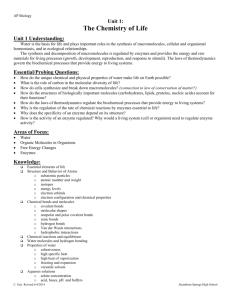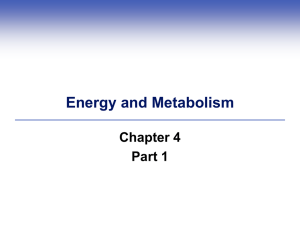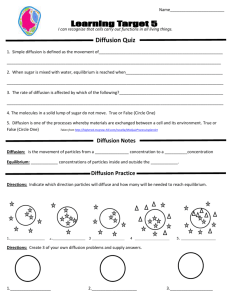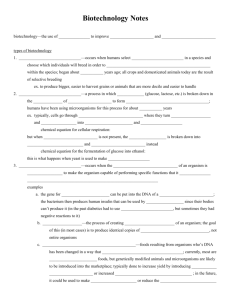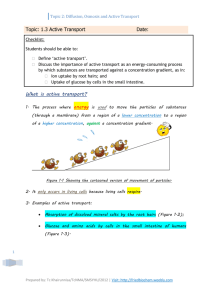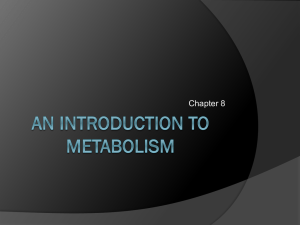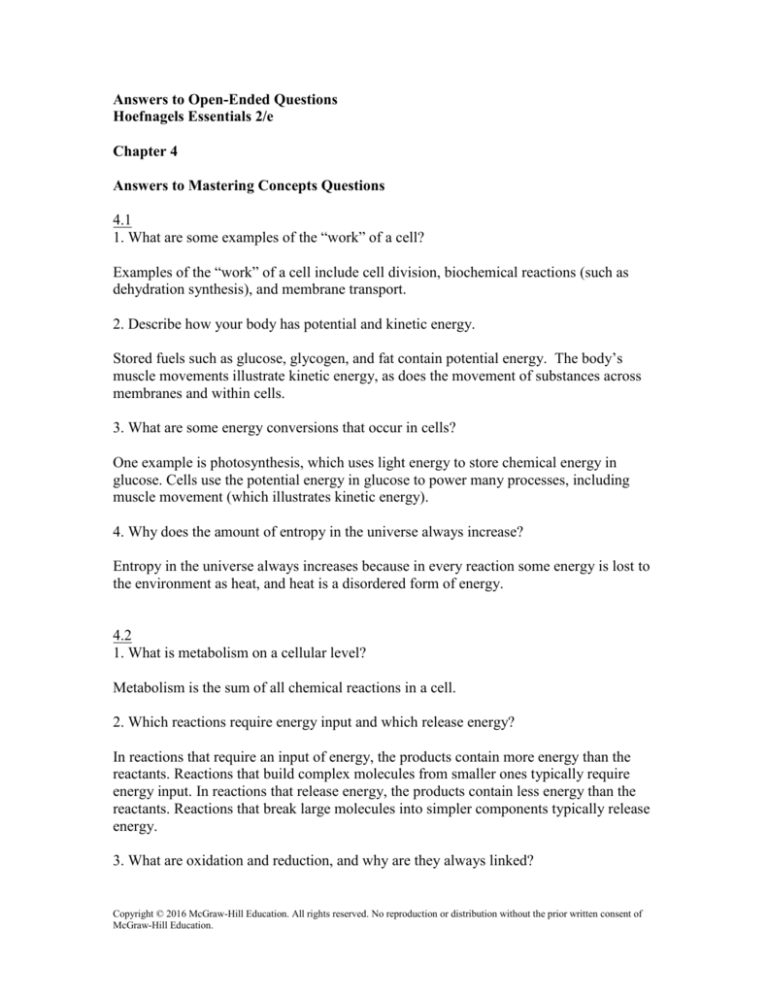
Answers to Open-Ended Questions
Hoefnagels Essentials 2/e
Chapter 4
Answers to Mastering Concepts Questions
4.1
1. What are some examples of the “work” of a cell?
Examples of the “work” of a cell include cell division, biochemical reactions (such as
dehydration synthesis), and membrane transport.
2. Describe how your body has potential and kinetic energy.
Stored fuels such as glucose, glycogen, and fat contain potential energy. The body’s
muscle movements illustrate kinetic energy, as does the movement of substances across
membranes and within cells.
3. What are some energy conversions that occur in cells?
One example is photosynthesis, which uses light energy to store chemical energy in
glucose. Cells use the potential energy in glucose to power many processes, including
muscle movement (which illustrates kinetic energy).
4. Why does the amount of entropy in the universe always increase?
Entropy in the universe always increases because in every reaction some energy is lost to
the environment as heat, and heat is a disordered form of energy.
4.2
1. What is metabolism on a cellular level?
Metabolism is the sum of all chemical reactions in a cell.
2. Which reactions require energy input and which release energy?
In reactions that require an input of energy, the products contain more energy than the
reactants. Reactions that build complex molecules from smaller ones typically require
energy input. In reactions that release energy, the products contain less energy than the
reactants. Reactions that break large molecules into simpler components typically release
energy.
3. What are oxidation and reduction, and why are they always linked?
Copyright © 2016 McGraw-Hill Education. All rights reserved. No reproduction or distribution without the prior written consent of
McGraw-Hill Education.
Oxidation is the loss of electrons from a molecule, atom, or ion; reduction is a gain of
electrons. Oxidation and reduction are always linked because they occur simultaneously.
If one molecule, atom, or ion loses electrons (is oxidized), then another must gain those
electrons (be reduced).
4. What is an electron transport chain?
Electron transport chains are groups of proteins that accept and then pass on electrons,
releasing small amounts of energy along the way.
4.3
1. How does ATP hydrolysis supply energy for cellular functions?
Hydrolysis of ATP breaks the bond to the third phosphate group, releasing energy. This
reaction is coupled to cellular reactions that require energy input.
2. Describe the relationship between energy-requiring reactions, ATP hydrolysis, and
cellular respiration.
The ATP that is produced in cellular respiration can undergo hydrolysis, releasing energy
that can be used to drive reactions that require energy input.
4.4
1. What do enzymes do in cells?
Enzymes speed up chemical reactions without being consumed in the process.
2. How does an enzyme lower a reaction’s activation energy?
Enzymes bring reactants into contact with each other so that less energy is required to
start the reaction.
3. What is the role of negative feedback in enzyme regulation?
In negative feedback, a reaction’s products inhibit the enzyme that catalyzes the reaction.
Negative feedback therefore slows the rate of a reaction when the products are abundant.
When the concentration of products falls, the reaction rate again increases.
4. List three conditions that influence enzyme activity.
Three conditions that can influence an enzyme’s activity are pH, temperature, and salt
concentration. Noncompetitive and competitive inhibitors can also reduce enzyme
activity.
4.5
1. What is diffusion?
Copyright © 2016 McGraw-Hill Education. All rights reserved. No reproduction or distribution without the prior written consent of
McGraw-Hill Education.
Diffusion is the net movement of a substance from an area of high concentration to an
area of low concentration. It is a consequence of random movement.
2. What types of substances diffuse freely across a membrane?
Lipids and small nonpolar molecules diffuse freely across a membrane.
3. What would happen to a plant cell in a hypertonic environment?
If a plant cell is in a hypertonic environment, then the concentration of solutes in the cell
is lower than the concentration of solutes in the surrounding environment. Water moves
out of the cell by osmosis, so the cell shrinks. Turgor pressure in the cell therefore
decreases.
3. How do differing concentrations of solutes in neighboring solutions drive osmosis?
Solutions with high concentrations of solutes have relatively low concentrations of water.
Water moves from a high concentration of water to a low concentration of water.
Therefore, water will move by osmosis from a low concentration of solutes (high
concentration of water) to a high concentration of solutes (low concentration of water).
4. Why does it cost energy for a cell to maintain a concentration gradient?
It costs energy for a cell to maintain a concentration gradient because random molecular
movement (diffusion) tends to dissipate gradients.
5. Distinguish between simple diffusion, facilitated diffusion, and active transport.
All three are forms of transport across membranes. Simple diffusion and facilitated
diffusion are forms of passive transport, in which molecules move down their
concentration gradient without the use of energy. In contrast, active transport moves
molecules against their concentration gradient, requiring an energy input. Simple
diffusion occurs without the use of a transport protein, whereas both facilitated diffusion
and active transport require transport proteins.
6. How do exocytosis and endocytosis use vesicles to transport materials across cell
membranes?
In exocytosis, a vesicle carries materials to be transported out of the cell. The lipid
bilayer surrounding the vesicle merges with the lipid bilayer of the cell membrane,
releasing the substance outside the cell. Conversely, in endocytosis, a vesicle forms as the
cell membrane pinches inward, bringing substances into the cell.
Copyright © 2016 McGraw-Hill Education. All rights reserved. No reproduction or distribution without the prior written consent of
McGraw-Hill Education.
Answers to Write It Out Questions
1. Some people claim that life’s high degree of organization defies the physical law that
says entropy always increases. What makes this statement false?
All reactions result in the loss of energy to the environment, in the form of heat. Life’s
high degree of organization defies this statement only if life is isolated from its
surroundings. Instead, incoming energy and matter allows organisms to maintain their
organization. As life maintains its complexity, something else always decreases in
complexity by a greater amount.
2. List some examples of energy-requiring and energy-releasing reactions that have been
introduced in previous chapters.
Dehydration synthesis and photosynthesis are examples of energy-requiring reactions, as
are most processes involved in the production of milk (see figure 3.11); hydrolysis and
respiration are examples of energy-releasing reactions.
3. Why is ATP called the cell’s “energy currency”?
ATP is called a cell’s “energy currency” because it provides energy for many chemical
reactions in the cell. Just as you can spend money in many ways, a cell can spend ATP
on many essential processes that require energy input.
4. In what ways is an enzyme’s function similar to engineers digging a tunnel through a
mountain rather than building a road over the peak?
Driving up a mountain requires a large amount of energy to counteract the force of
gravity; building a tunnel saves cars from having to climb the peak to get to the other
side. Many chemical reactions release energy but have a high activation energy. The
enzyme reduces this activation energy so the reaction proceeds more rapidly.
5. Use what you know about enzymes to propose an explanation for why our bodies
cannot digest the cellulose in dietary fiber. Also, why would a cell’s fat-digesting
enzymes not be able to digest an artificial fat such as Olestra (see chapter 2)?
The active site of an enzyme has a specific shape. Humans can digest some
polysaccharides, such as starch, but lack the enzymes that bind to cellulose. Likewise,
artificial fat such as Olestra has a different shape from natural fat, so human digestive
enzymes do not recognize Olestra.
6. Considering that enzymes are essential to all cells, including microbes, why might
refrigeration and freezing help preserve food?
Copyright © 2016 McGraw-Hill Education. All rights reserved. No reproduction or distribution without the prior written consent of
McGraw-Hill Education.
The warmer the temperature, the faster a chemical reaction proceeds (unless the
temperature is so high that the enzyme is denatured). Food spoilage reactions happen
rapidly at room temperature, but if food is refrigerated or frozen, the same chemical
reactions occur much more slowly or not at all.
7. When a person eats a fatty diet, excess cholesterol accumulates in the bloodstream.
Cells then temporarily stop producing cholesterol. What phenomenon described in the
chapter does this control illustrate?
The control of cholesterol level illustrates negative feedback.
8. Diffusion is an efficient means of transport only over small distances. How does this
relate to a cell’s surface-area-to-volume ratio (see chapter 3)?
Cells acquire nutrients and dispose of wastes by diffusion. Diffusion is efficient only
over small distances, but that is sufficient as long as all parts of the cell’s interior are
close to the surface of the cell (which they will be if the surface area is high relative to
the cell’s volume).
9. Liver cells are packed with glucose. If the concentration of glucose in a liver cell is
higher than in the surrounding fluid, what mechanism could the cell use to import even
more glucose? Why would only this mode of transport work?
The cell would use active transport to move the glucose against its concentration
gradient. A concentration gradient is a form of potential energy, so the liver cell would
need to expend some type of energy in order to import more glucose molecules. Building
a concentration gradient is analogous to a biker pedaling uphill: Both processes require
energy input and increase the potential energy in the system.
10. List three ways the content in this chapter relates to an organism’s ability to maintain
homeostasis.
Maintaining homeostasis means maintaining internal conditions within a certain range
even if the environment changes. Many examples are possible; here are three
possibilities. (1) Maintaining homeostasis requires chemical reactions to build DNA,
proteins, lipids, and many other substances that make up the cell. Enzymes catalyze these
reactions. (2) Many reactions that enable a cell to maintain homeostasis require energy in
the form of ATP. (3) Membrane transport relates to homeostasis by enabling cells to
maintain optimal concentrations of solutes in cells and body fluids.
Answers to Pull It Together Questions
1. Add competitive inhibitor and noncompetitive inhibitor to this concept map.
Copyright © 2016 McGraw-Hill Education. All rights reserved. No reproduction or distribution without the prior written consent of
McGraw-Hill Education.
Both “Competitive inhibitor” and “Noncompetitive inhibitor” could connect with the
phrase “are substances that reduce the activity of an” to “Enzyme.”
2. What are some examples of potential energy and kinetic energy other than those
included in the concept map?
Examples of potential energy include a rock on top of a hill and the bonds of glucose
molecules. Examples of kinetic energy include walking, a rock falling down a mountain,
and the motion of a molecule.
3. Add the terms substrate, active site, and activation energy to this concept map.
“Enzymes” could connect with the phrase “act on” to “Substrate.” In turn, “Substrate”
could connect with the phrase “binds to the” to “Active site.” “Enzymes” could connect
with the phrase “speed chemical reactions by lowering the” to “Activation energy.”
4. Where does passive transport fit on this concept map?
“Facilitated diffusion” and “Simple diffusion” could connect with the phrase “are forms
of” to “Passive transport.” “Passive transport” could then connect with the phrase “does
not require” to “ATP.”
Copyright © 2016 McGraw-Hill Education. All rights reserved. No reproduction or distribution without the prior written consent of
McGraw-Hill Education.


